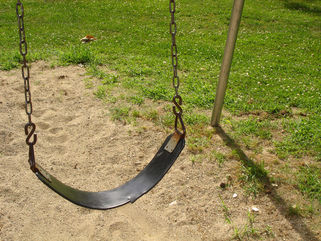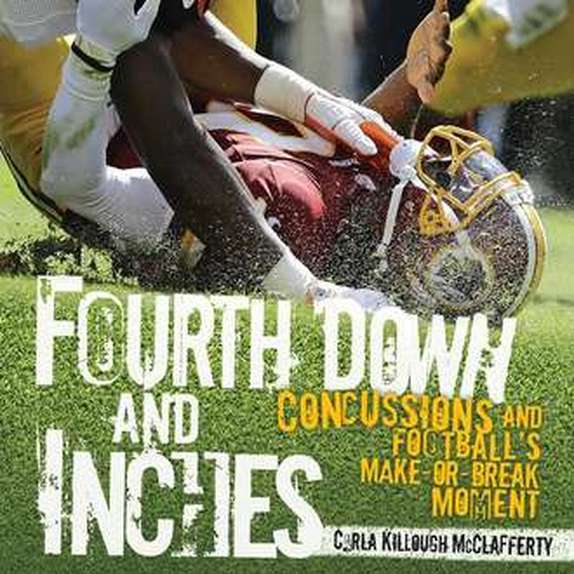 photo by Katherine Johnson photo by Katherine Johnson Carla's 14-month-old son Corey fell off a swing in the back yard and died of a head injury. You want to think such a thing could never happen in your family, that it was a freak accident... But in reading Carla Killough McClafferty's book subtitled CONCUSSION AND FOOTBALL'S MAKE-OR-BREAK MOMENT, it's clear the risk of death and brain damage is higher than I ever imagined. Especially for kids who play football, but also for kids who play soccer or ride bicycles, or swing on swings... Corey suffered a minor bump on the head the day before he fell from the swing. After he died, the doctor told Carla that the two falls were a factor in her son's death. But she didn't really understand what had happened until some twenty-five years later when she researched this book.  Carla Killough McClafferty Carla Killough McClafferty "I studied what happens in the brain when one is a victim of Second Impact Syndrome or SIS. I understood in a different way exactly what happened in my son's brain in those minutes immediately following his fall." "In the end, the research was much more personal than I thought it would be." FOURTH DOWN AND INCHES tells of a Purdue University study of the Jefferson High football team in Lafayette, Indiana. The study showed brain impairment not just in the boys who suffered concussions during the season, but also in boys who suffered repeated hard knocks to the head, but never showed any signs of concussion. "At first we thought the scanner was broken," one researcher said, referring to the boys' functional MRI test results. Before, during and after the 2009 season, the players underwent two tests. One measured how well they remembered words and shapes during a 20-minute test, as well as the speed and accuracy of their responses. MRI scans showed brain functions like thought, speech, movement and sensation.
When the before and after test results were compared, four boys who experienced lots of hard impacts to the head (as measured by an accelerometer in their helmets) but no concussions, showed the same neurological changes to the brain as three boys who had been diagnosed with concussion during the season. The risk then, for these players of suffering SIS is huge. A player might sustain a life-altering injury without showing any outward sign. A different study at Virginia Tech study is that the helmet accelerometers showed they young boys experienced impacts of the same severity of force as high school and college players. One hit was so hard, it would be like running into a brick wall at 20-miles an hour. Carla says her book is not an attack on football. The reality of repetitive head trauma is balanced with love of the game. "In FOURTH DOWN, I present the facts, then leave the reader to draw their own conclusions. The point of the book is to look at the cutting edge research on concussions and head injuries and how these issues affect people. I address recognizing a player with a concussion and what the experts say they should do after a concussion. My hope is that the book will inform young athletes about the issues so they understand why they shouldn't ignore symptoms of concussion." Along with the danger of SIS comes the specter of Chronic Traumatic Encephalopathy or CTE, which boxers commonly suffer and has recently been diagnosed in some pro-football players. CTE can be diagnosed only after death and has been discovered in the brains of men who died and donated their brains to science. CTE is irreversible and progressive brain damage that results from repetitive brain trauma. When a teenage rugby player died in 2006 after a concussion, his parents donated his brain for study. Scientists were surprised at what they found--the first evidence of CTI suffered by a teenager. Delving into the personal side of the science of head injury was not easy for Carla, but she says, "The emotional cost of writing this book is worth if even one athlete tells a coach that he might have a concussion and does not return to play too soon, risking second impact syndrome." "I don't think I'm courageous at all. I was willing to go where the research took me. The book allowed me to get to know the parents of Nathan Stiles and Eric Pelly, both teen athletes who lost their lives as a result of concussions. As they shared with me the lives and deaths of their children, I grieved with them and for them. Although Corey has been gone for more than 25 years, his loss is always with me and times like this bring it back to me with fresh pain." FOURTH DOWN AND INCHES: CONCUSSIONS AND FOOTBALL'S MAKE-OR-BREAK MOMENT by Carla Killough McClafferty received a starred review in Publishers Weekly, selection by the Junior Library Guild and the ALA YALSA Nominee List for 2014 Nonfiction Award. Top photo thanks to Katherine Johnson https://www.flickr.com/photos/aka_kath/ Comments are closed.
|
I'm fascinated to discover little-known history, stories of people and events that provide a new perspective on why and how things happened, new voices that haven't been heard, insight into how the past brought us here today, and how it might guide us to a better future.
I also post here about my books and feature other authors and their books on compelling and important historical topics. Occasionally, I share what makes me happy, pictures of my garden, recipes I've made, events I've attended, people I've met. I'm always happy to hear from readers in the blog comments, by email or social media. Archives
September 2023
Categories
All
|

